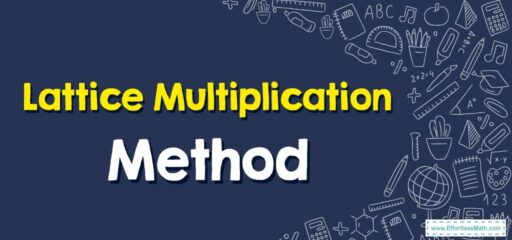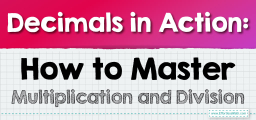How to Use Lattice Multiplication Method
Lattice multiplication is a method of multiplication that uses a grid to help organize the multiplication and addition needed in multi-digit multiplication.

A Step-by-step Guide to Using Lattice Multiplication Method
Lattice multiplication is a fun and different way to multiply numbers. This method is quite visual and can help you see how multiplication works, especially with larger numbers. Here’s a step-by-step guide on how to use it:
Let’s say we want to multiply 23 by 45.
The Absolute Best Book for 4th Grade Students
Step 1: Draw the Lattice Grid
Draw a \(2×2\) square grid for our example because we have two digits in both numbers.
Step 2: Write the Numbers
Write the first number, 23, along the top of the grid, one digit above each column. Write the second number, 45, along the right side of the grid, one digit beside each row. Your lattice should look like this:
2 | 3
4 |
5 |
Step 3: Draw the Diagonals
Draw a diagonal line through each square. The line should start from the bottom right of each square and end at the top left.
Step 4: Multiply and Write the Products
Now, for each box, multiply the digit at the top of the column by the digit at the end of the row. Write the result inside the box, with the tens digit going in the upper triangle (above the diagonal) and the ones digit going in the lower triangle (below the diagonal). If the result is a single digit, put a zero in the top triangle.
For example, the top left box represents 2 (from 23) times 4 (from 45), which equals 08, so write 08 in the box. The top right box is 3 (from 23) times 4 (from 45), which is 12, so write 12 in the box. Do the same for the bottom row. The grid should look like this:
2 | 3
4 | 08 | 12
5 | 10 | 15
A Perfect Book for Grade 4 Math Word Problems!
Step 5: Add Along the Diagonals
Finally, add the numbers along the diagonals from the bottom right to the top left. If a diagonal’s sum is more than 9, carry the tens digit over to the next diagonal.
In our case, the sums would be:
- The rightmost diagonal has only one number: 5
- The next diagonal has 1 (from the previous box), 2 (from the 12 in the upper box), and 0 (from the 10 in the lower box): 1 + 2 + 0 = 3.
- The next diagonal has 1 (from the 12 in the upper box), 0 (from the 10 in the lower box), and 0 (from the 08 in the upper box): 1 + 0 + 0 = 1.
- The leftmost diagonal has only one number: 0 (from the 08 in the upper box)
So, write these sums next to the corresponding diagonal, from top to bottom: 0, 1, 3, 5.
Step 6: Read the Result
Read the result from left to right. In this case, the product of 23 and 45 is 1035.
The lattice method can be extended for numbers of any size, and even for decimals, and it’s a good way to visually understand how multiplication works.
The Best Math Books for Elementary Students
Related to This Article
More math articles
- Understanding Trigonometry: How to Calculate the Area of Triangles
- What is a Perfect SAT Score?
- How to Pass the CBEST Test: A Step-By-Step Guide
- 10 Most Common 5th Grade ACT Aspire Math Questions
- Top 10 8th Grade Georgia Milestones Assessment System Math Practice Questions
- CHSPE Math Formulas
- How to Interpret Pie Graphs? (+FREE Worksheet!)
- 7th Grade NDSA Math Worksheets: FREE & Printable
- 6th Grade NJSLA Math Worksheets: FREE & Printable
- Number Properties Puzzle – Challenge 5


















What people say about "How to Use Lattice Multiplication Method - Effortless Math: We Help Students Learn to LOVE Mathematics"?
No one replied yet.